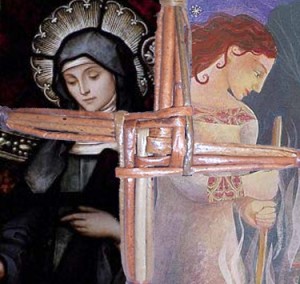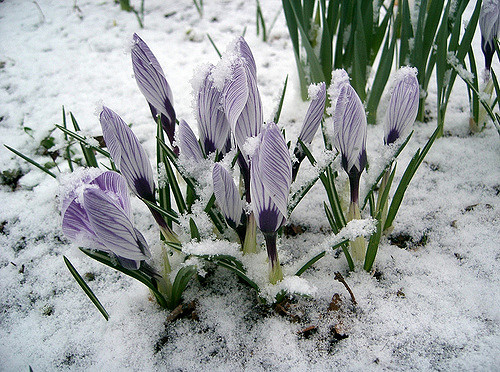TWH – The time has once again come for many modern Pagans and polytheists to celebrate the fire festival of Imbolc, sacred to the goddess Brigid, patroness of poets, healers, and smiths. The modern celebration is often held on Feb. 1 or Feb. 2. However, due to work schedules and other practical considerations, rituals and other group events can also be found throughout the week and weekend.
Similarly, Feb. 1 marks the feast day of Saint Brigid of Ireland, the patron saint of poets, dairymaids, blacksmiths, healers, cattle, fugitives, Irish nuns, midwives, and newborn babies. In Kildare, Ireland’s town square, a perpetual flame is kept lit and housed in a statue that pays homage to Brigid. The 2018 festivities for La Feile Bride in Kildare started on Jan. 31 and will continue through Feb. 11. The center that hosts the event is now celebrating its 26th year.

Brigid: Saint and Goddess.
There are many other notable observances held during these first few days of February. For example, in some Celtic recon traditions, this is a time to honor Cú Chulainn’s three-day combat with his foster brother Fer Diad. According to the chronology in the Táin Bó Cúailnge, the epic battle happened during these dark mid-winter days.
In the Urglaawe Heathen tradition, Feb. 2 marks the beginning of the twelve-day observance of Entschtanning (the emergence). It is a time to clean out hearths and honor feminine spirits and female ancestors.
Additionally, the Shinto Festival of Setsubun is held on Feb. 3. This holiday is more commonly known as the Japanese bean-throwing festival. Around Japan and the world, people visit their local Buddhist or Shinto temples to toss soy beans in order to drive away the evil spirits of winter. Setsubun is translated as “seasonal division” and is considered to be the final day of winter on the Shinto calendar.
This seasonal theme is carried through in many secular and modern religious observances, such as EarthSpirit Community’s Feast of Lights and Groundhog Day. And, as columnist Manny Tejeda-Moreno capture in his most recent column: Uh-Oh! It’s Magic. It is also the time of one of the most famous nearly-sacred American secular traditions: the Super Bowl.
In the Southern Hemisphere, modern Pagans are beginning their harvest season, celebrating Lammas, Lughnasadh and other similar festivals. Autumn will soon be at their doorstep.
And not long after the rituals of Imbolc end, our cultures come upon St. Valentine’s Day (Feb. 14) and Lupercalia (Feb. 15).
Over the past week, several Imbolc-inspired articles were published in mainstream media.The student paper for the University of North Texas interviewed Pagans at the Denton CUUPS chapter for its article. “According to Cynthia Talbot, treasurer at Denton Covenant of Unitarian Universalist Pagans (DCUUPS), Imbolc is the Celtic fire festival that celebrates the transition point away from winter toward spring.”
Metro, a UK based news site, published an article titled, “Imbolc, Candlemas and Brigid’s Day 2018: what is the festival all about?” The Hindustan Times, based in New Dehli, offered the article: “Imbolc and Blue Moon: You’ve probably never heard of these Wicca festivals.”

[Photo Credit: Philip Chapman-Bell / Flickr]
“Imbolc is one of those holidays that is easily overlooked. I admit I don’t usually do a whole lot in observance of this holy night. It is a festival consisting of rituals of purification and protection […] For me it doesn’t hold the magical sway over my psyche that festivals like Samhain and Walpurgistnacht does. However, upon second glance, as with all things, Imbolc holds a deeper occult meaning that resonates with the witch inside.” – Coby Michael Ward, “Candlemas, Imbolc, and the Serpent Fire”
“The Cailleach did not depart without a bit of drama in Ireland. I woke Imbolc eve to snowflakes. We had hail that fell like shrapnel. We had sleet. She lashed us and threw down steely stair rods of rain. The wind bayed. Your fingers froze. Friends speculated that our cloth Brat Bríd’s would be ripped from the bushes and clothes lines and we would be bereft of the goddess blessing this spring. As nightfall descended the cloud cover was so thick the supermoon was as veiled as if she had still been eclipsed. But enter the Divine Feminine reborn…and repurposed.” – Bee Smith, “Exit the Cailleach, Welcome Brigid!”
“When people lived in round houses, the hearth fire was literally in the center of the house. […] The hearth was literally the sacred center of the home. This can be seen in Brigidine customs. Brigid’s role in smooring (subduing) the hearth fire, the raking of embers, and covering them with ash, so they’d continue to lightly burn during the sleeping hours of the household in a safe fashion. The fire is subdued but kept alive; it must not go out. Symbolically it was key that the hearth fire never completely went out, except on Beltaine when the household fires were relit from a communal fire.” – Finnchuil, “Kindling Brigid’s Purifying Fire”
“Imbolc is a time for getting ready, a halfway point because cold gray winter and warm glorious spring. My son and I like to flip through the seed catalogs as they arrive, one after another, in the mail. My kids weigh monumental decisions like which summer camp will they pick–Nature Camp at a nearby nature reserve or Farm Camp at a small, family farm in deep South Jersey. There is so much fun in nature ahead of us. At Imbolc, it is almost in reach, the plans ready to bear fruit.” – Kate Delaney, “Sown Seeds & Garden Dreams at Imbolc“
The Wild Hunt is not responsible for links to external content.
To join a conversation on this post:
Visit our The Wild Hunt subreddit! Point your favorite browser to https://www.reddit.com/r/The_Wild_Hunt_News/, then click “JOIN”. Make sure to click the bell, too, to be notified of new articles posted to our subreddit.
Pingback: Imbolc 2018 |